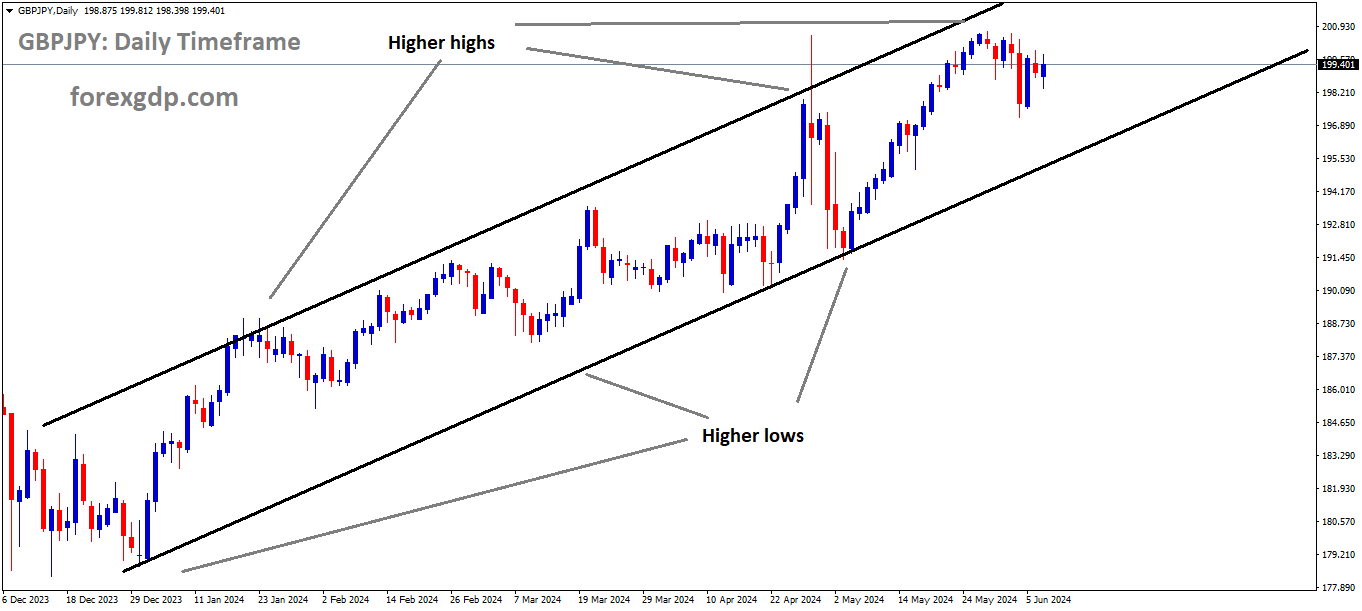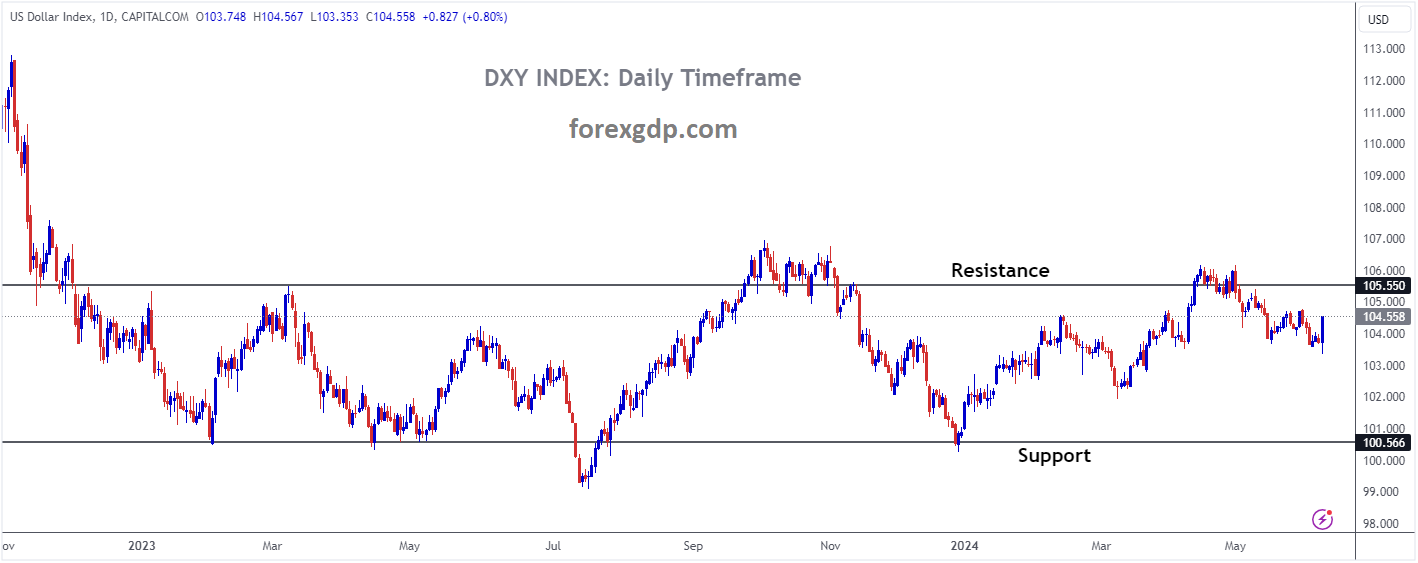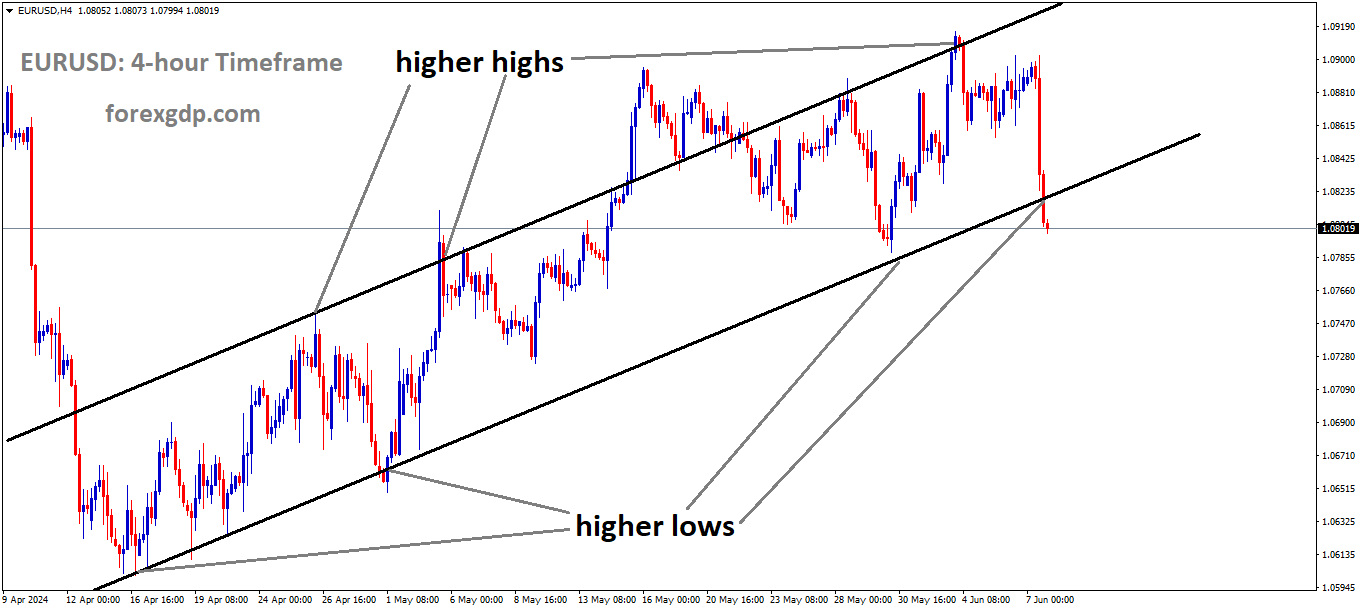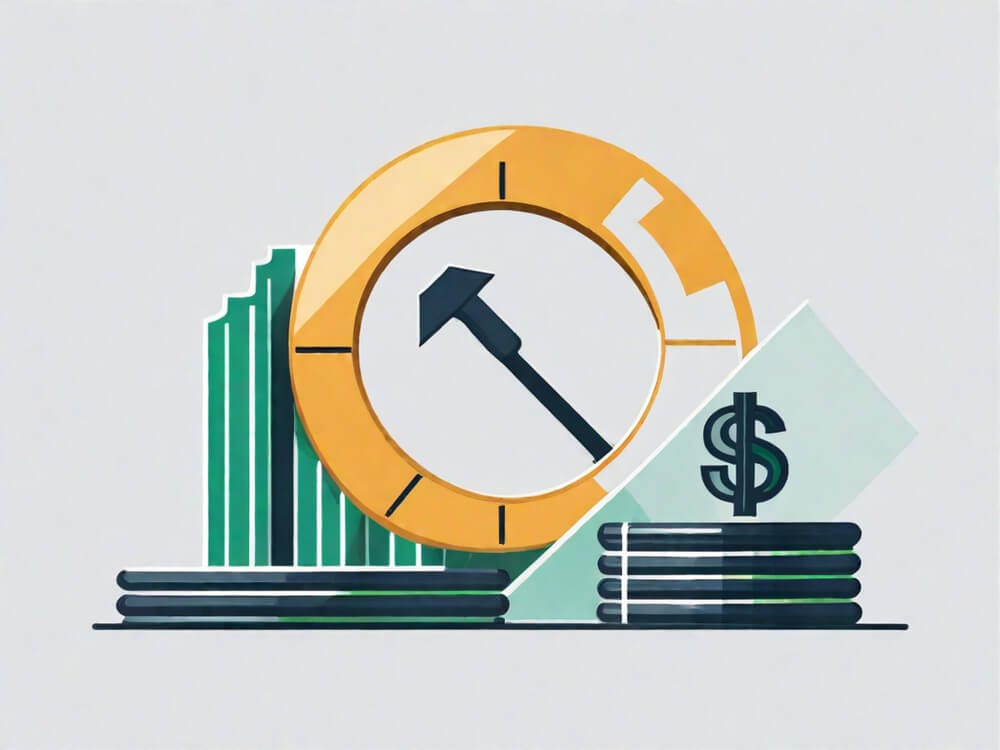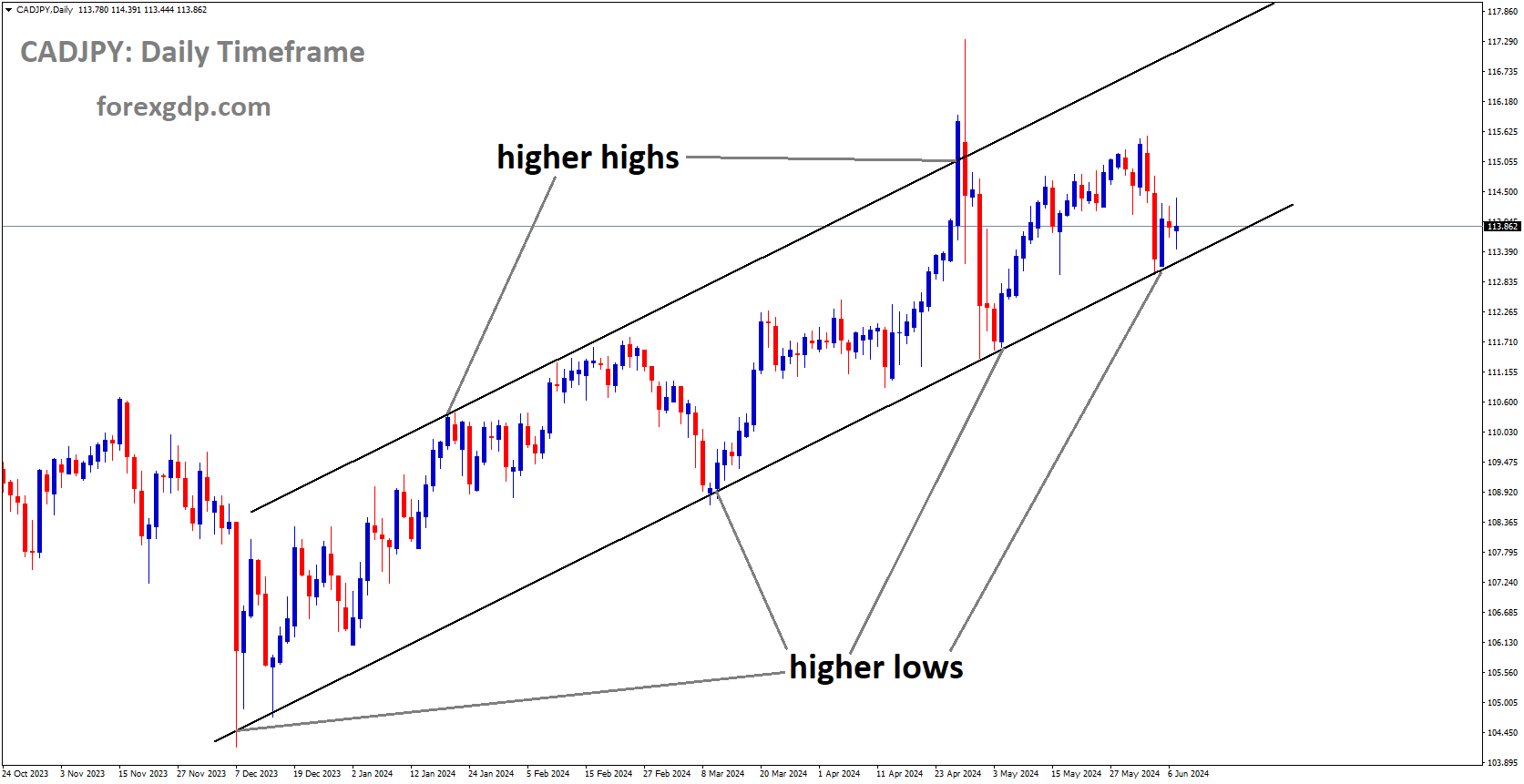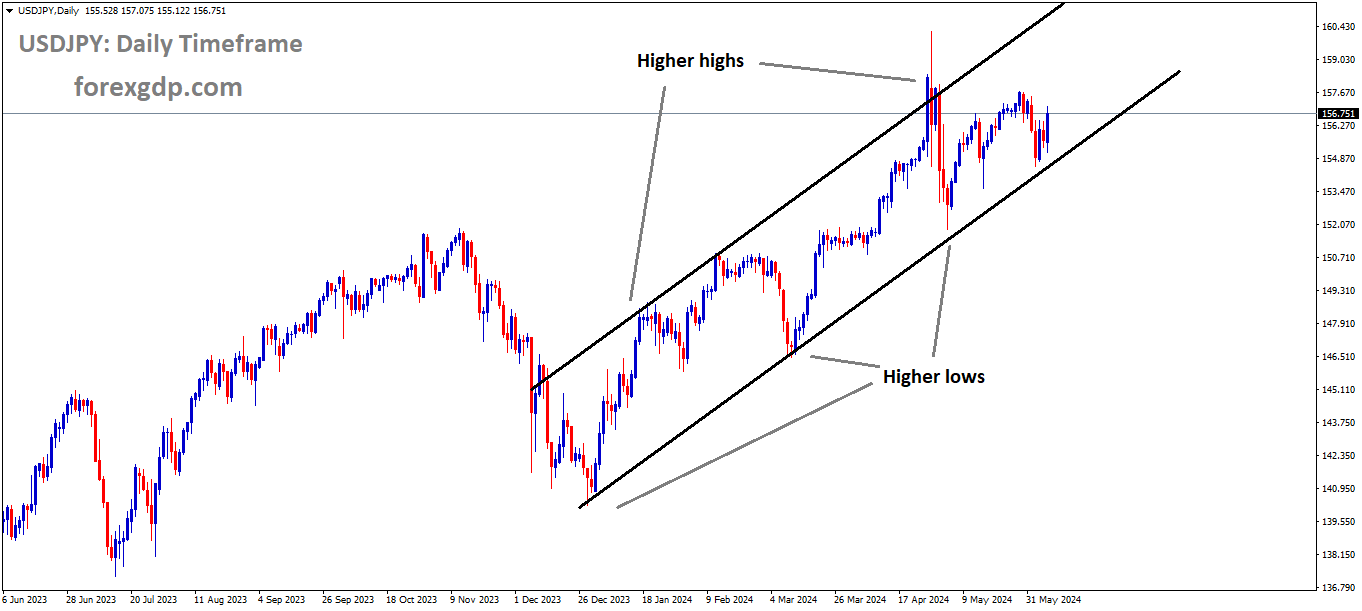JPY: BOJ May Hint at Bond Tapering Plan Next Week, Sources Say
The Bank of Japan is expected to keep the interest rates at 0.10% this week due to Bond purchases tapering measures has to taken. The BoJ Governor Ueda said Tapering of steady Bond purchases will keep Japanese Yen little stronger against Global currencies. Almost $5 Trillion in the Balance sheet, we need to came at $4.8 Trillion by reducing Bond purchases, there by steadying Japanese Yen.
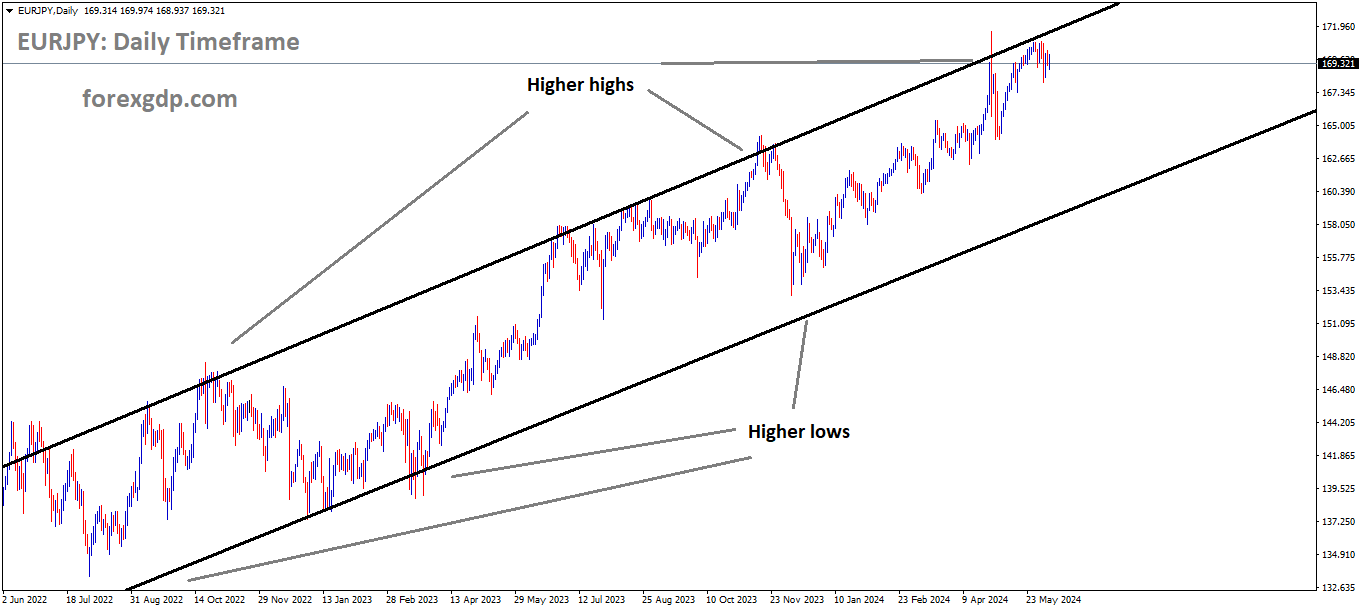
EURJPY is moving in Ascending channel and market has reached higher high area of the channel
Bank of Japan (BOJ) policymakers are contemplating strategies to reduce their bond buying program, with the possibility of offering new guidance as early as next week, according to sources familiar with their discussions. This move would mark a significant step toward reducing the BOJ’s substantial balance sheet, which currently stands at almost $5 trillion.
While specific details have not been finalized, potential measures include reducing monthly bond purchases or providing clearer plans for a gradual tapering process to prevent abrupt spikes in yields. The BOJ’s balance sheet, which is nearly 1.3 times the size of Japan’s economy, has prompted discussions about the necessity of scaling it down.
The topic is expected to be a focal point at the BOJ’s upcoming policy meeting on June 13-14. However, any decision may be postponed if the Japanese bond market experiences renewed volatility.
BOJ policymakers recognize the importance of market conditions in determining the timing of tapering, aiming to avoid disruptions in financial markets. At the upcoming meeting, the BOJ is anticipated to maintain short-term interest rates within the range of 0-0.1% while monitoring indicators such as wage growth and inflation to assess the need for further policy adjustments.
Although conditions appear conducive to tapering, with Japanese government bond yields stabilizing, market risks remain, including potential impacts from events such as the US nonfarm payrolls data and the Federal Reserve’s policy-setting meeting.
The BOJ’s transition from its previous policy of negative interest rates and yield curve control (YCC) to potential quantitative tightening (QT) presents challenges. While BOJ Governor Kazuo Ueda has hinted at eventual tapering, the timing remains uncertain.
The BOJ’s approach to tapering is likely to differ from the Fed’s fixed schedule, preferring a more discretionary approach that allows for flexibility in adjusting the pace of tapering based on evolving market conditions. This approach aims to provide guidance while maintaining room for maneuverability.
Overall, the BOJ’s potential shift towards tapering reflects its efforts to navigate the complexities of monetary policy normalization amid ongoing economic challenges and market dynamics.
JPY: Japan Growth Strategy Panel Cautions on Weak Yen Impact
It seems like the Bank of Japan (BoJ) is taking measures to taper its bond purchases in order to reduce its balance sheet from almost $5 trillion to around $4.8 trillion. BoJ Governor Ueda has indicated that tapering steady bond purchases will help keep the Japanese Yen stronger against global currencies.
USDJPY Market price is moving in Ascending channel and market has fallen from the higher high area of the channel
By reducing bond purchases, the BoJ aims to stabilize the yen by preventing abrupt fluctuations. This approach suggests a cautious strategy to manage the yen’s value while gradually adjusting its balance sheet.
Keeping interest rates at 0.10% aligns with the BoJ’s broader monetary policy objectives amid these tapering measures. The BoJ’s actions reflect its efforts to navigate the balance between supporting economic growth and maintaining currency stability in global markets.
Japanese Prime Minister Fumio Kishida’s advisory panel on growth strategies has urged both the government and the Bank of Japan (BOJ) to remain vigilant regarding the impact of the yen’s depreciation. The panel’s call reflects the government’s increasing concerns over a weakened yen, which poses challenges for Kishida’s administration as it contributes to higher living costs for households by inflating prices of imported goods such as food and fuel.
The panel’s draft action plan on Kishida’s “new capitalism” program emphasizes the need for the government and the BOJ to collaborate closely to achieve the 2% inflation target in a sustainable and stable manner through flexible policy management. It highlights the potential impact of the yen’s depreciation on inflation over the next six months to a year, underscoring the importance of monitoring price developments closely.
The reference to the weak yen’s impact also appears in a draft of this year’s long-term economic policy roadmap, which maintains pressure on the BOJ to consider raising interest rates or scaling back its extensive bond-buying program. Some analysts suggest that such measures could help slow the yen’s decline.
BOJ Governor Kazuo Ueda has previously ruled out using monetary policy to directly influence exchange-rate movements. However, he has indicated the possibility of raising rates if the weak yen leads to higher-than-expected inflation.
Kishida’s cabinet is expected to approve both the action plan and the economic policy roadmap later this month. Additionally, the draft calls for increased government support to facilitate the global expansion of Japan’s entertainment content industries, including animation, manga, films, and gaming.
JPY: BoJ Plans Tapering Amid Market Caution
The Bank of Japan (BoJ) appears to be implementing strategies aimed at gradually diminishing its bond acquisitions, with the objective of scaling down its balance sheet from nearly $5 trillion to approximately $4.8 trillion. BoJ Governor Ueda has intimated that the deliberate reduction in consistent bond acquisitions will serve to fortify the Japanese Yen against the influences of international currencies.
GBPJPY is moving in Ascending channel and market has fallen from the higher high area of the channel
Through the reduction of bond acquisitions, the BoJ endeavors to stabilize the yen, thereby averting sudden and erratic fluctuations in its value. This methodology implies a cautious approach to managing the yen’s valuation while gradually recalibrating its balance sheet.
Maintaining the interest rates at 0.10% is in harmony with the BoJ’s overarching monetary policy objectives, particularly in light of these measures aimed at tapering. The BoJ’s initiatives underscore its endeavors to navigate the delicate equilibrium between bolstering economic growth and upholding the stability of the yen in the global currency markets.
The Bank of Japan (BoJ) is considering reducing its bond purchases, potentially announcing new guidance next week as it aims to trim its substantial $5 trillion balance sheet without causing disruptions in financial markets.
At its upcoming policy meeting on June 13-14, 2024, the BoJ is expected to focus on tapering its bond purchases. While maintaining short-term interest rates at 0-0.1%, the central bank seeks to clarify its approach to gradually scaling back bond buying. This poses a challenge due to potential market volatility, although the current favorable conditions, with the 10-year Japanese government bond (JGB) yield below 1%, may support tapering if external risks remain stable, such as US payroll data and Federal Reserve policies. Governor Kazuo Ueda and his team are navigating the delicate balance between reducing intervention while managing Japan’s significant public debt.
For markets, this development is significant as the Japanese bond market closely monitors the BoJ’s potential tapering decisions. Investors should prepare for potential fluctuations, as the central bank is likely to provide loose guidance rather than a strict timetable. The BoJ plans emergency purchases if bond yields spike sharply, aiming to smooth the transition and maintain market stability.
In the broader context, Japan’s gradual tapering of bond purchases signifies a step back from massive intervention. The BoJ’s balance sheet, five times the size of the Federal Reserve’s relative to GDP, underscores the scale of its past bond-buying interventions. By gradually reducing these purchases, the BoJ aims to orchestrate a controlled exit from aggressive monetary policies without unsettling the market. This transition could serve as a model for other central banks facing similar challenges in managing their policy unwindings in the future.
USD: Anticipated Outcomes for Next Week’s Fed Meeting on Interest Rates
The US FED will kept the rates unchanged at this week meeting due to Robust Job numbers, Cooling inflation, Cooling GDP Numbers in the Market. Core PCE index came at lower than expected makes US Dollar see saw in the market. September month rate cut expected poll is down to 50.7% from 68.7% previous poll.
USD Index Market price is moving in Ascending channel and market has rebounded from the higher low area of the chanel
The upcoming meeting of the Federal Open Market Committee (FOMC) is not anticipated to result in any changes to monetary policy, with the federal funds rate expected to remain within its current range of 5.25-5.50%. This rate, at its highest in 23 years, has been maintained since last July in an effort to curb inflationary pressures.
It would come as a significant surprise to financial markets if the Fed were to either raise or lower the rate at this meeting. Market expectations, as indicated by the CME Group’s Fedwatch Tool, largely anticipate a rate cut in September at the earliest. Following a Bureau of Labor Statistics report indicating a stronger-than-expected job market in May, bets for a September rate cut slightly decreased from 68.7% to 50.8%.
Recent statements from central bank officials suggest a willingness to maintain the current rate for an extended period. Fed policymakers are awaiting greater confidence that inflation is on a downward trajectory toward the 2% annual target before considering any adjustments to the key interest rate.
While the interest rate decision itself may not be the focus of attention, the FOMC members’ quarterly economic projections, particularly regarding the path of the fed funds rate, are expected to attract significant interest. With inflation proving more persistent than anticipated, projections for rate cuts in 2024 may be revised downward, with one or two cuts now more likely than three.
The release of the Consumer Price Index for May, scheduled for Wednesday morning before the Fed announcements, could influence these projections. Higher-than-expected inflation could reignite discussions of potential rate hikes, while lower inflation could reinforce the possibility of rate cuts.
Market participants will closely watch Fed Chair Jerome Powell’s post-announcement press conference for insights into the interest rate outlook and potential market-moving commentary. Powell’s previous remarks suggest a reluctance to raise rates further despite earlier inflationary pressures, a sentiment likely to be reiterated.
USD: Focus on US Fed Monetary Policy Decision, CPI Data Ahead
At this week’s meeting, the US Federal Reserve is anticipated to maintain unchanged interest rates, influenced by strong employment figures, subdued inflation, and a moderation in GDP growth. The Core Personal Consumption Expenditures (PCE) index, which came in lower than anticipated, has led to fluctuations in the US Dollar’s performance in the market. Expectations for a rate cut in September have decreased, with the latest poll indicating a decline from 68.7% to 50.7%.
USD Index Market price is moving in box pattern and market has fallen from the resistance area of the pattern
The upcoming Federal Open Market Committee (FOMC) meeting on June 13 is drawing significant attention as market participants await the decision on whether the US Federal Reserve will maintain interest rates at their current level of 5.25% to 5.50%, or opt for a surprise rate cut earlier than anticipated.
According to a Bloomberg poll conducted on June 7, the vast majority of analysts (78 out of 80) expect the Federal Reserve to keep rates unchanged in June. This sentiment aligns with the views of UOB Global Economics & Markets Research economist Alvin Liew, who emphasizes the Fed’s likely message of patience, indicating that rates may remain elevated for a longer duration until the Fed is confident that inflation is progressing sustainably toward its 2% target.
Liew maintains the view that the Fed will maintain the current federal funds target rate (FFTR) within the range of 5.25% to 5.50% and extend this level beyond June. He anticipates two 25 basis points rate cuts in 2024, with one expected in September and another in December. Attention will also be focused on the Dotplot, a graphical representation of the interest rate projections by Federal Reserve policymakers, to discern any adjustments to the number of projected rate cuts for 2024.
USD: Markets Await Start of Fed Easing Cycle
The US Federal Reserve is expected to keep interest rates unchanged at this week’s meeting. This decision comes against the backdrop of robust job numbers, tempered inflation, and a cooling GDP outlook in the market. The Core Personal Consumption Expenditures (PCE) index, which fell below expectations, has contributed to volatility in the US Dollar’s valuation. Furthermore, the likelihood of a rate cut in September has decreased, with the latest poll indicating a decline from 68.7% to 50.7%.
EURUSD is moving in Ascending channel and market has reached higher low area of the channel
The upcoming Federal Open Market Committee (FOMC) meeting scheduled for June 12 will be closely watched by markets, particularly as policymakers provide updated economic projections, including a new dot plot, and Fed Chair Powell holds a post-meeting press conference. With the economy showing signs of softening and inflation remaining above the Fed’s 2.0% target, there’s speculation about when the Fed’s easing cycle might begin.
Here’s a summary of what to expect at the FOMC meeting:
- Economic Growth: Fed officials upgraded their 2024 growth estimate to 2.1% at the March meeting, but recent data has shown a downward revision to Q1 GDP and softer consumer spending. Despite this, a soft landing for growth remains the Fed’s base case, and updated projections are expected to remain near potential growth levels.
- Inflation: In March, the Fed projected a slow decline in inflation from 2.6% in 2024 to 2.0% by 2026. Recent developments, including disappointing inflation readings, have shaken confidence, but the disinflationary trend is expected to resume. Therefore, major shifts in the Fed’s inflation projections are not anticipated.
- Federal Funds Rate: The March dot plot showed a gradual reduction in the fed funds rate, with possibly one rate cut shifting into 2025. However, policymakers are not in a rush to cut rates, given healthy growth and labor market conditions. Expectations for rate cuts this year vary, but the longer-run fed funds rate projection may move slightly higher.
- Powell’s Press Conference: Powell’s remarks will be closely scrutinized, especially regarding the timing of the first rate cut, the labor market outlook, and the degree of policy restrictiveness. With economic data evolving, Powell may clarify the Fed’s new forecasts and address questions about future monetary policy actions.
In conclusion, while the odds of a July rate cut are currently low, the market may be underestimating the Fed’s potential actions. With economic conditions warranting potential rate cuts later in the year, policymakers have time to assess the economy’s state before making any decisions. However, expectations are for 2 to 3 cuts this year, likely starting in September, to provide insurance against a recession.
JPY: Japan Q1 GDP Expected to Decline Less than Initially Reported Due to Capex Upgrade: Reuters Poll
The Japan Q1 GDP data is expected to come at -0.50% in the next week due to Private consumption lower to -0.70% and EXIM data came at -0.30%, this two main factors shaved the Japan GDP in the First quarter.
CADJPY is moving in Ascending channel and market has reached higher low area of the channel
According to a Reuters poll, the Japanese economy likely experienced a slightly slower contraction than initially reported in the January-March quarter. Economists anticipate that revised data from the Cabinet Office, to be released on Monday, will show that the pace of gross domestic product (GDP) contraction narrowed to an annualized rate of 1.9%, slightly better than the previously reported 2.0% contraction. This adjustment would result in an unchanged quarter-on-quarter contraction of 0.5%.
The revision is primarily attributed to upgrades in capital spending figures, which are indicative of private demand. The initial estimate suggested a 0.8% decline, but economists now expect a slightly smaller 0.7% decrease in capital expenditure.
However, challenges persist in the Japanese economy. Despite expectations for growth to return in the current quarter, supported by tax cuts and wage increases, higher import costs due to a weaker yen are anticipated to squeeze consumption. Additionally, disruptions in the automotive sector are likely to exert further pressure.
In the preliminary data, private consumption, a significant component of the Japanese economy, fell by 0.7% in the first quarter, largely attributed to rising living costs driven by the weak yen. Furthermore, external demand, represented by exports minus imports, contributed to shaving off 0.3 percentage points from overall GDP figures.
On a separate note, data from the Bank of Japan (BOJ) expected on June 12 is anticipated to reveal that the corporate goods price index rose by 2.0% year-on-year and 0.4% month-on-month in May.
USDJPY – Holds Steady Despite Soft Household Spending
Projections for Japan’s Q1 GDP data indicate a contraction of -0.50% expected next week. This downturn is primarily attributed to a decline in private consumption, which is anticipated to register at -0.70%. Additionally, the external demand data, represented by exports minus imports (EXIM), is forecasted to contribute to the GDP contraction with a figure of -0.30%. These two factors are pivotal determinants that have collectively contributed to the downward revision of Japan’s GDP in the first quarter.
USDJPY is moving in Ascending channel and market has reached higher low area of the channel
On Friday, the Japanese yen exhibited stability, with the USD/JPY pair trading at 155.50 during the European session, marking a marginal 0.06% decline at the time of writing.
Japan’s economic landscape continues to face challenges, as evidenced by a slip in household spending. In April, household spending decreased by 1.2% month-on-month, contrasting with the 1.2% increase seen in March and falling short of the anticipated 0.2% growth. While on a yearly basis, household spending showed a modest rise of 0.5%, it still fell short of market expectations, which had forecasted a 0.6% increase.
The reluctance in household spending can be attributed to persistently high inflation levels and unfavorable economic conditions. With Japan’s GDP data for the first quarter due on Monday, projections paint a concerning picture. The economy is anticipated to have contracted by 0.5% quarter-on-quarter in Q1, following stagnant growth in the previous quarter. Furthermore, on an annualized basis, the economy is expected to have declined by 2%, indicating a precarious situation that could potentially skirt recessionary territory.
Looking ahead, the Bank of Japan’s meeting on June 14th gains significance, particularly in light of a potentially weak GDP report. While the central bank has hinted at policy normalization, a lack of action in response to the economic downturn could further undermine the already vulnerable Japanese yen.
Meanwhile, in the US, attention turns to the release of the nonfarm payrolls report for May. Despite being overshadowed by inflation data, this release remains a key event on the economic calendar, capable of significantly influencing the US dollar. Market expectations for May’s nonfarm payrolls stand at 185,000, mirroring the previous month’s gain of 175,000.
Don’t trade all the time, trade forex only at the confirmed trade setups
Get more confirmed trade signals at premium or supreme – Click here to get more signals , 2200%, 800% growth in Real Live USD trading account of our users – click here to see , or If you want to get FREE Trial signals, You can Join FREE Signals Now!





